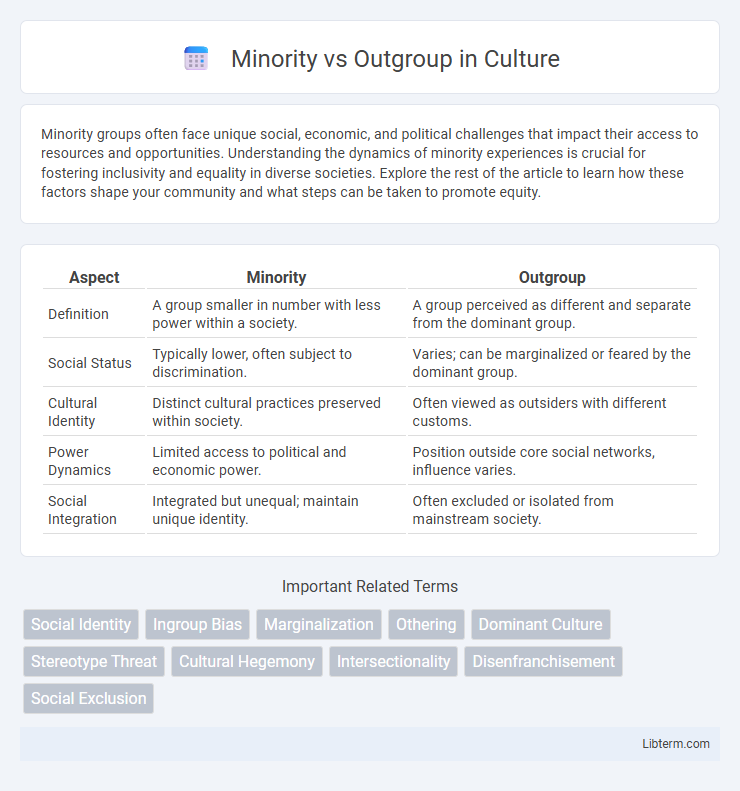Minority groups often face unique social, economic, and political challenges that impact their access to resources and opportunities. Understanding the dynamics of minority experiences is crucial for fostering inclusivity and equality in diverse societies. Explore the rest of the article to learn how these factors shape your community and what steps can be taken to promote equity.
Table of Comparison
| Aspect | Minority | Outgroup |
|---|---|---|
| Definition | A group smaller in number with less power within a society. | A group perceived as different and separate from the dominant group. |
| Social Status | Typically lower, often subject to discrimination. | Varies; can be marginalized or feared by the dominant group. |
| Cultural Identity | Distinct cultural practices preserved within society. | Often viewed as outsiders with different customs. |
| Power Dynamics | Limited access to political and economic power. | Position outside core social networks, influence varies. |
| Social Integration | Integrated but unequal; maintain unique identity. | Often excluded or isolated from mainstream society. |
Defining "Minority" and "Outgroup": Key Differences
Minority" refers to a group with fewer members or less power within a larger population, often characterized by distinct cultural, ethnic, or social traits, while "Outgroup" denotes any group an individual perceives as different from their own "ingroup," regardless of size or status. Key differences include the sociopolitical implications tied to minorities, such as marginalization and systemic disadvantages, whereas outgroups are defined mainly through psychological and social identity processes involving in-group/out-group dynamics. Understanding these distinctions is crucial for studying social hierarchies, group conflicts, and identity formation in diverse societies.
Historical Contexts of Minorities and Outgroups
Historical contexts reveal that minorities often face systemic exclusion and marginalization based on ethnicity, religion, or culture, resulting in limited access to social, political, and economic resources. Outgroups are socially constructed categories perceived as different or threatening by the dominant group, frequently leading to stereotyping and discrimination. Understanding these distinctions highlights how historical power dynamics shape the experiences and identities of marginalized populations.
Social Identity Theory: Understanding Group Boundaries
Minority and outgroup distinctions are pivotal in Social Identity Theory, which explains how individuals categorize themselves and others to establish group boundaries. This theory emphasizes that people derive part of their self-concept from membership in social groups, leading to favoritism toward their ingroup and potential bias against outgroups. Understanding these dynamics elucidates the psychological mechanisms behind intergroup conflict and social cohesion.
Minority Status: Demographics and Power Dynamics
Minority status is defined by demographics such as race, ethnicity, religion, or language, often coupled with limited access to power and resources compared to dominant groups. Power dynamics play a crucial role, as minorities typically face systemic inequalities and social exclusion that perpetuate their marginalization. These intersections of demographic characteristics and power imbalances shape the lived experiences and social positioning of minority groups.
Outgroup Perception: Psychology and Stereotyping
Outgroup perception in psychology involves the cognitive and emotional processes that people use to categorize others as members of a different social group, often leading to stereotyping and bias. Research in social psychology shows that outgroup members are frequently perceived through simplified, generalized traits that reinforce negative stereotypes, impacting intergroup relations and contributing to prejudice. Understanding the mechanisms of outgroup perception, such as in-group favoritism and outgroup homogeneity effect, is crucial for addressing social biases and promoting inclusive attitudes.
Minority Rights vs. Outgroup Marginalization
Minority rights emphasize the protection and promotion of individual freedoms, cultural identity, and equal representation for groups distinguished by ethnicity, religion, or language. Outgroup marginalization occurs when dominant groups exclude or discriminate against these minorities, restricting access to political power, economic resources, and social inclusion. Ensuring robust legal frameworks and social policies is crucial to preventing marginalization and upholding minority rights within diverse societies.
Cultural Representation: Minority vs. Outgroup in Media
Minority groups often receive limited and stereotypical cultural representation in media, reinforcing societal biases and marginalization. Outgroups, perceived as culturally distant or socially alien, face misrepresentation that emphasizes otherness rather than shared humanity. Accurate and diverse portrayal of both minorities and outgroups is crucial for fostering inclusion and combating prejudice in media narratives.
Inclusion, Exclusion, and Social Integration
Minority groups often face exclusion through social, economic, and political barriers that hinder full inclusion and subsequent social integration. Outgroups, defined by perceived differences in identity or beliefs, experience exclusion that reinforces in-group cohesion but limits cross-group interaction and inclusion. Effective social integration requires inclusive policies and practices that reduce prejudice, promote equal opportunities, and facilitate meaningful intergroup contact across both minorities and outgroups.
Policy Implications: Addressing Inequality for Minorities and Outgroups
Policies targeting inequality for minorities and outgroups must prioritize equitable access to education, healthcare, and employment opportunities, recognizing systemic barriers faced by these groups. Implementing affirmative action and anti-discrimination laws enhances social inclusion and economic mobility, reducing disparities in income and representation. Data-driven approaches and community engagement enable tailored interventions that address the unique needs of diverse minority and outgroup populations.
Building Bridges: Fostering Understanding Across Groups
Building bridges between minority and outgroup populations enhances social cohesion by promoting empathy and reducing prejudice. Intergroup dialogues and cooperative projects facilitate mutual understanding and dismantle stereotypes, fostering inclusive communities. Emphasizing shared goals and values encourages collaboration, leading to stronger, more resilient social networks.
Minority Infographic

 libterm.com
libterm.com